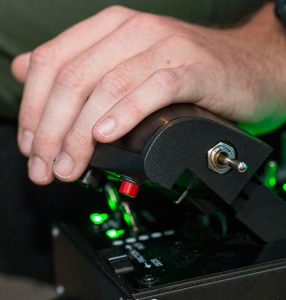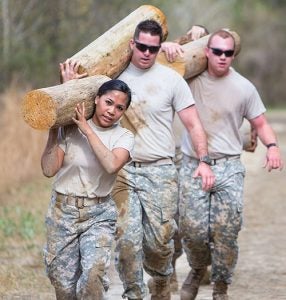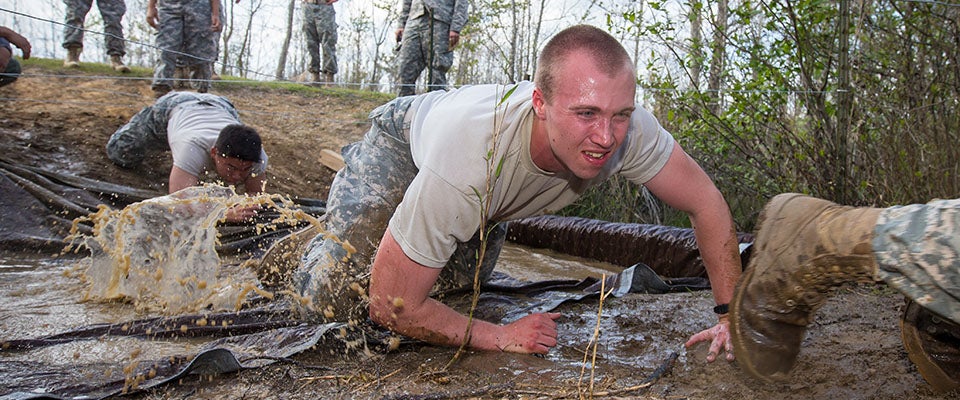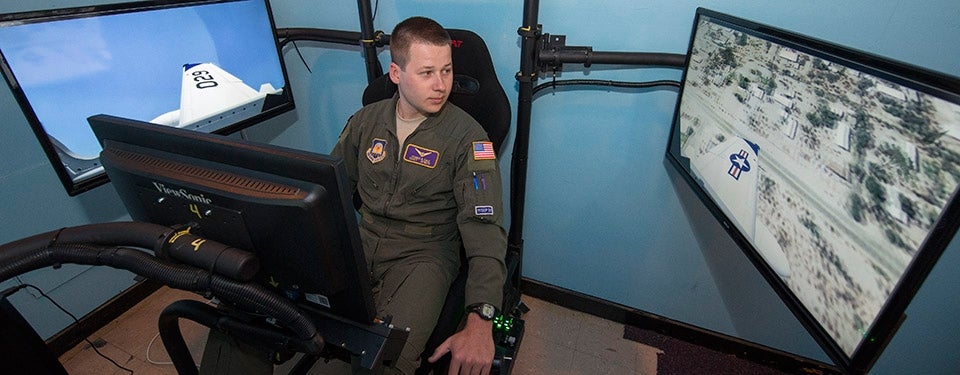‘GREAT BENEFIT’
ECU offers ROTC cadets unique training in UNC system
A new training course and flight simulator used by U.S. Army and Air Force cadets at East Carolina University is helping develop the nation’s future military leaders.
Unique among schools in the UNC system and across the country, ECU offers a dedicated outdoor training area at the West Research Campus that features maneuver and marksmanship space, a rappel tower and problem-solving obstacle course. A state-of-the-art flight simulator called the Combat Pilot Pro 4 located in Wright Annex can provide a computer model of public airports or military landing fields anywhere in the world.
“The addition of the flight simulator and problem-solving obstacle course means that our ECU cadets receive training only available in a few other university locations in the country,” said Dr. Glen G. Gilbert, professor and dean of the College of Health and Human Performance, home to ECU’s ROTC programs.
Students began using the obstacle course last fall, while the flight simulator arrived in April.

Realistic controls in the flight simulator provide good experience for cadets training to be pilots.
The simulator offers a realistic representation of the cockpit of an aircraft, complete with pilot’s chair, throttle and control panel. It provides 180-degree views with three computer screens in front and on either side of the pilot. It can be configured to show any public airport or military air field in the world, as well as hundreds of types of aircraft and any weather conditions.
Not all Air Force cadets have their private pilot’s license, so the simulator offers valuable training for those who will eventually get certification, like 2nd Lt. Sarah Riggs. Riggs just graduated from ECU and is headed to pilot training at Columbus Air Force Base in Mississippi. Her goal is to be a fighter pilot.
“It definitely gives you a feel for the real thing,” Riggs said.
Students who may be interested in flying can try it for free instead of paying up to $120 an hour for simulator use offered by private companies, said Capt. Korey Silknitter, assistant professor of aerospace studies at ECU.
It also lets cadets gain much needed practice for the Air Force Test of Basic Aviation Skills, which is a required test for anyone interested in flying for the Air Force, Silknitter said.
“I believe we are the only Air Force ROTC detachment in North Carolina with a simulator. I am not aware of any AFROTC detachment in the Southeast region that has a simulator, let alone one that provides the realism ours does,” Silknitter said. “It is definitely a great benefit to our students/cadets, and we are greatly appreciative that ECU was able to purchase it for us.”
Another first in the UNC system is the Army ROTC training course at ECU’s West Research Campus, a former Voice of America site which covers almost 600 acres northwest of Greenville.
“I’m not aware of any other school in the UNC system that has access to anything similar,” said Capt. Kevin D. Prevost, assistant professor of military science and executive officer with the ECU Army ROTC. “That kind of area for maneuver training is accomplished in most ROTC programs by travelling to actual Army posts or other Army training sites. Moreover, that ECU has funded the construction of a rappel tower and leader reaction/obstacle course only reinforces ECU’s commitment to being recognized as the most military-friendly institution of higher learning in North Carolina.”

ECU Army Cadets Clara Sarmiento, at left, Jacob Kriminger and Roberto Garcia work as a team on the obstacle course at ECU’s West Research Campus.
The leader reaction course consists of seven obstacles. Three of the stations test strength, coordination and agility while four require physical fitness along with critical thinking, decision-making and teamwork skills. For instance, soldiers work as a team to transport critical equipment from one side of a destroyed bridge to the other without falling in a simulated river, using only two boards and three leftover support beams.
“The leader obstacle course is important to the ROTC program because it allows us to develop critical thinking and teamwork skills in accomplishing goals,” said Chris Rudkowski, an ECU Army ROTC and N.C. National Guard cadet and business management major from Apex. “The course provides cadets who have a fear of heights or are unsure if they can accomplish a physically demanding challenge the ability to overcome those obstacles. When we revisit the course, those developed skills become assets in leading other cadets through the same challenges.”
“I think that the beauty of the course is that it combines both physical obstacle and leader reaction, making it an optimal leader development trainer,” said Lt. Col. Joseph Pierce, professor of military science and the commander of ECU’s Army ROTC program.
ECU is the only Army ROTC program in the UNC system that has an engagement skills trainer for marksmanship training. The next closest one is at James Madison University, and most are located at military colleges or academies, Pierce said.
“I can tell you that not every college in the country is as fortunate as us to have this much support from the university dedicated to the development of future Army leaders,” said ECU’s Army ROTC officer Prevost.
This year marks the 100th anniversary of the national ROTC, which has a total of 275 programs at colleges and universities in the United States, the District of Columbia, Puerto Rico and Guam with an enrollment of more than 30,000.
College ROTC programs produce more than 70 percent of the second lieutenants who join the active Army, the Army National Guard and the U.S. Army Reserve. More than 40 percent of current active duty Army General Officers were commissioned through the ROTC, according to the U.S. Army Cadet Command.

(Video by Rich Klindworth, ECU News Services)
ECU Army Cadet Christopher Rudkowski hugs the ground on the belly crawl part of the obstacle course. This obstacle is designed to replicate soldiers moving under fire by crawling no more than 16 inches above the ground and beneath an obstacle to move into a better position to engage the enemy without exposing themselves.
